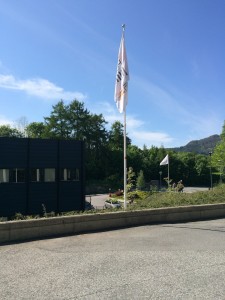On Wednesday, following the walking tour of Bergen, the group and I ventured onto another tram for a visit to the CMR office to learn more about Renewable Energy in Norway. There we received a fabulous lunch and listened to presentations from 4 speakers about different forms of renewable energy and their implications throughout Norway. The four topics of discussion included Carbon Capture and Storage, Geothermal Energy, Offshore Wind, and Hydrogen power. Of the four, I took a great interest in CCS and Geothermal Energy. Both Geothermal and CCS are topics discussed in class prior to our visit to Norway, so I really appreciated having the opportunity to learn of actual research and projects taking place in both areas.
The presentation for CCS was given by Charlotte Krafft, and began with a brief description of CCS and why it is a beneficial process for Norway. She also went on to liste some of the efforts being made by Norway to become a greener country and ultimately achieve their goal of keeping climate change below 2°C. CCS is the process of depositing carbon removed from the atmosphere into a reservoir. Initially CO2 was stored on a temporary basis, but a more permanent storage has been more recently developed with its overall purpose being to prevent atmospheric and marine accumulations of greenhouse gases. Without CCS’ removal of CO2 from the areas that are likely polluted by greenhouse gases, we face a huge challenge in confronting the issue of climate change;however, Charlotte expressed optimism in Norway’s ability to use and further develop their CCS potential. This includes more access to storage locations as well as storage materials that lack the risks associated with the materials used for the more temporary forms of storage. CMR is currently focused on developing new technologies that will allow for permanent storage of CO2. Ideal developments will also be leak proof, which will greatly eliminate the worry of stored CO2 escaping back into the atmosphere. CMR is also seeking solutions for challenges associated with subsurface saline aquifers, reservoirs, ocean water, aging oil fields, and other carbon sinks on captured CO2 from large point sources such as fossil fuel power plants. The subsurface aquifers received much attention in the presentation, and it was explained that aquifers are a body of saturated rocks that allows easy flow of water. Aquifers have to be both permeable and porous, and include rock types such as sandstone, conglomerate, fractured limestone, and unconsolidated sand and gravel. The speaker stressed the importance of developments in regards to the aquifers because they are a key player in the storage process as a result of their being the entity doing the actual storing of CO2, so it is of the most benefit that the properties mentioned above, that contribute to the proper functioning of the aquifer are the same properties that will lead to the permanent storage of CO2 without the risk of leaks. A large amount of money has been allotted for CMR’s further exploration for permanent means of storage. In addition to CCS, we received a presentation on Geothermal Energy in Norway from Kirsti Midttøme, she discussed the usages of the energy stored in bedrock and ground water and how it can be used to supply a sustainable source of energy to house and buildings. This energy also has the ability to be used for both heating and cooling. Realizing the Geothermal Energy is available in Norway and nearly anywhere, it is puzzling that such a small percentage of Norway’s renewables is made up of Geothermal, but future goals and research are in affect to ensure the continued growth of Geothermal’s role as a competitive renewable. Some of these goals include gaining an understanding of the geothermal properties of typical Norwegian rocks, groundwater seepage, geotechnical condition in relation to establishing geothermal works, and an actual estimate for the amount of energy able to be extracted. Norway’s expertise in oil and gas industry has provided them the opportunity to contribute to the international geothermal business. CMR works to complement other associations and partners by monitoring and testing various concepts and solutions.


